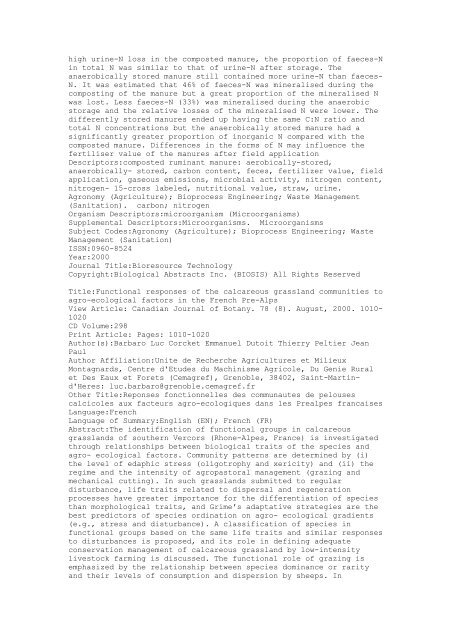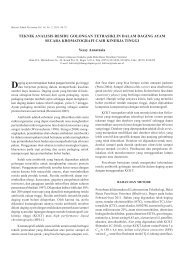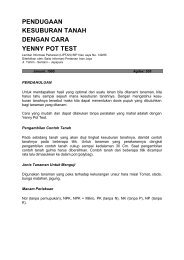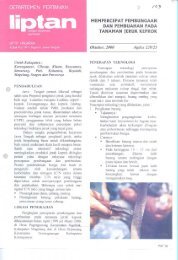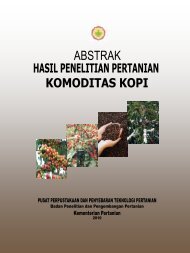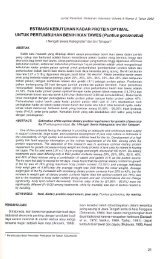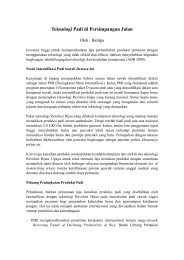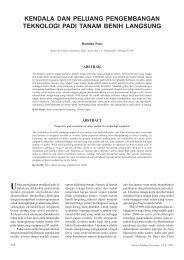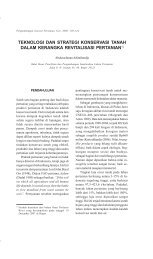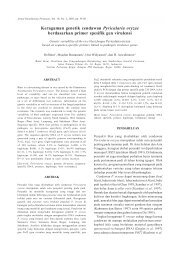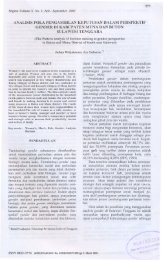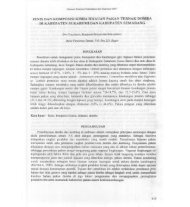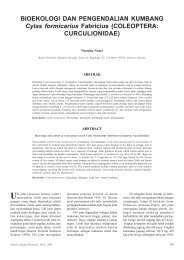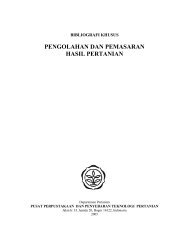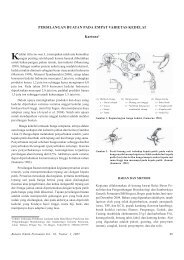Komoditas : KAMBING - Pustaka
Komoditas : KAMBING - Pustaka
Komoditas : KAMBING - Pustaka
Create successful ePaper yourself
Turn your PDF publications into a flip-book with our unique Google optimized e-Paper software.
high urine-N loss in the composted manure, the proportion of faeces-N<br />
in total N was similar to that of urine-N after storage. The<br />
anaerobically stored manure still contained more urine-N than faeces-<br />
N. It was estimated that 46% of faeces-N was mineralised during the<br />
composting of the manure but a great proportion of the mineralised N<br />
was lost. Less faeces-N (33%) was mineralised during the anaerobic<br />
storage and the relative losses of the mineralised N were lower. The<br />
differently stored manures ended up having the same C:N ratio and<br />
total N concentrations but the anaerobically stored manure had a<br />
significantly greater proportion of inorganic N compared with the<br />
composted manure. Differences in the forms of N may influence the<br />
fertiliser value of the manures after field application<br />
Descriptors:composted ruminant manure: aerobically-stored,<br />
anaerobically- stored, carbon content, feces, fertilizer value, field<br />
application, gaseous emissions, microbial activity, nitrogen content,<br />
nitrogen- 15-cross labeled, nutritional value, straw, urine.<br />
Agronomy (Agriculture); Bioprocess Engineering; Waste Management<br />
(Sanitation). carbon; nitrogen<br />
Organism Descriptors:microorganism (Microorganisms)<br />
Supplemental Descriptors:Microorganisms. Microorganisms<br />
Subject Codes:Agronomy (Agriculture); Bioprocess Engineering; Waste<br />
Management (Sanitation)<br />
ISSN:0960-8524<br />
Year:2000<br />
Journal Title:Bioresource Technology<br />
Copyright:Biological Abstracts Inc. (BIOSIS) All Rights Reserved<br />
Title:Functional responses of the calcareous grassland communities to<br />
agro-ecological factors in the French Pre-Alps<br />
View Article: Canadian Journal of Botany. 78 (8). August, 2000. 1010-<br />
1020<br />
CD Volume:298<br />
Print Article: Pages: 1010-1020<br />
Author(s):Barbaro Luc Corcket Emmanuel Dutoit Thierry Peltier Jean<br />
Paul<br />
Author Affiliation:Unite de Recherche Agricultures et Milieux<br />
Montagnards, Centre d'Etudes du Machinisme Agricole, Du Genie Rural<br />
et Des Eaux et Forets (Cemagref), Grenoble, 38402, Saint-Martind'Heres:<br />
luc.barbaro@grenoble.cemagref.fr<br />
Other Title:Reponses fonctionnelles des communautes de pelouses<br />
calcicoles aux facteurs agro-ecologiques dans les Prealpes francaises<br />
Language:French<br />
Language of Summary:English (EN); French (FR)<br />
Abstract:The identification of functional groups in calcareous<br />
grasslands of southern Vercors (Rhone-Alpes, France) is investigated<br />
through relationships between biological traits of the species and<br />
agro- ecological factors. Community patterns are determined by (i)<br />
the level of edaphic stress (oligotrophy and xericity) and (ii) the<br />
regime and the intensity of agropastoral management (grazing and<br />
mechanical cutting). In such grasslands submitted to regular<br />
disturbance, life traits related to dispersal and regeneration<br />
processes have greater importance for the differentiation of species<br />
than morphological traits, and Grime's adaptative strategies are the<br />
best predictors of species ordination on agro- ecological gradients<br />
(e.g., stress and disturbance). A classification of species in<br />
functional groups based on the same life traits and similar responses<br />
to disturbances is proposed, and its role in defining adequate<br />
conservation management of calcareous grassland by low-intensity<br />
livestock farming is discussed. The functional role of grazing is<br />
emphasized by the relationship between species dominance or rarity<br />
and their levels of consumption and dispersion by sheeps. In


